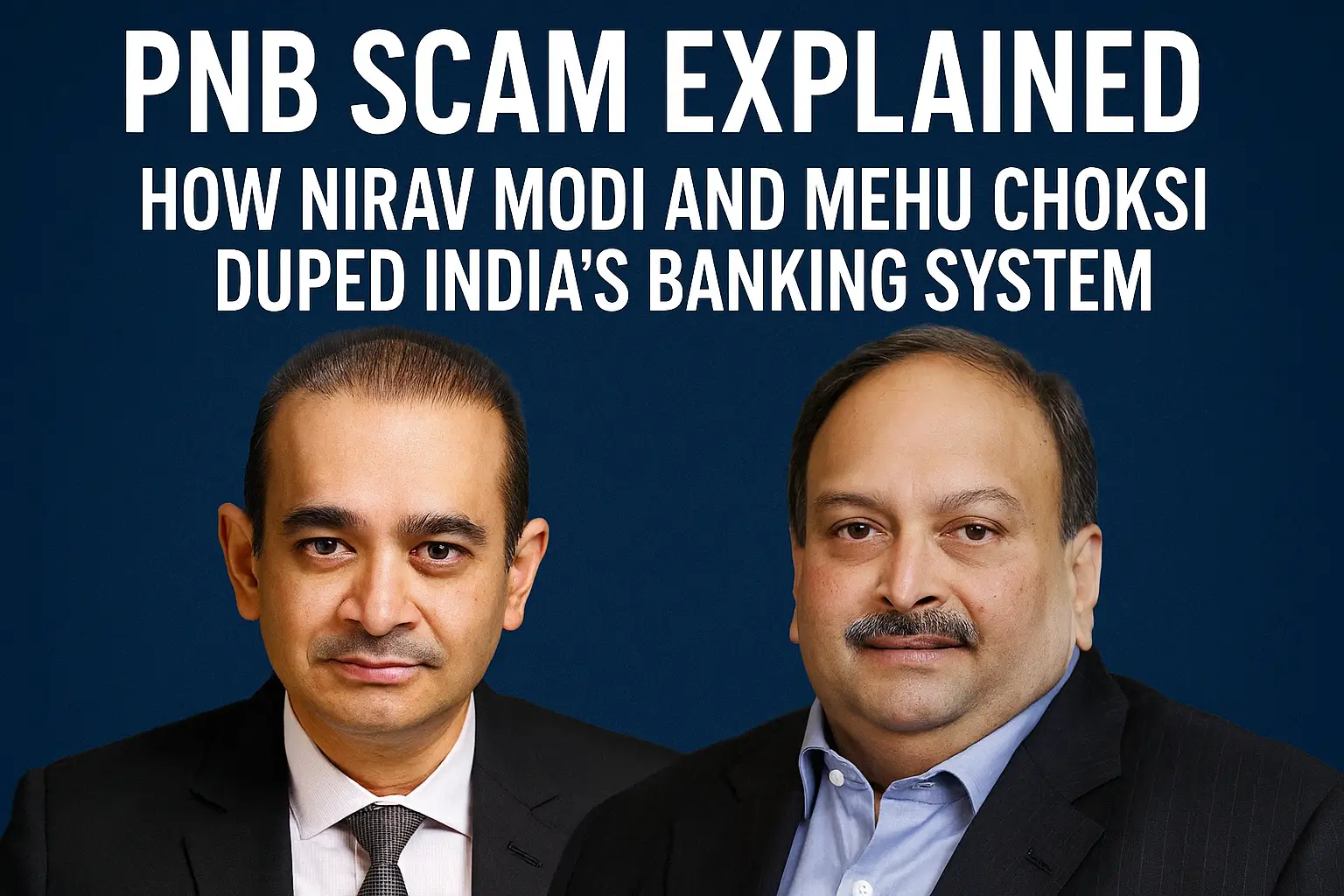One of the biggest banking scandals in Indian history, the Punjab National Bank (PNB) scam involving Nirav Modi and Mehul Choksi, shocked the entire nation. This massive fraud, valued at over ₹13,000 crore, exposed glaring loopholes in India’s banking system and raised serious questions about internal controls, accountability, and regulatory oversight.
In this article, we’ll break down the PNB scam, explain how it happened, highlight the roles played by Nirav Modi and Mehul Choksi, and discuss its impact on India’s banking system.
What is the PNB Scam?
The PNB scam refers to a banking fraud detected in early 2018 at Punjab National Bank, India’s second-largest state-owned lender. The fraud involved unauthorized issuance of Letters of Undertaking (LoUs) worth approximately ₹13,000 crore (USD 2 billion) to Nirav Modi, Mehul Choksi, and their associated companies.
These LoUs were used to obtain credit from foreign branches of other Indian banks without proper collateral or documentation.
Who Are Nirav Modi and Mehul Choksi?
Nirav Modi:
A well-known diamond merchant and luxury jeweler, Nirav Modi was the face of several premium jewelry brands and featured on Forbes lists. He built a global empire with stores in Hong Kong, London, New York, and Mumbai.
Mehul Choksi:
Choksi, Nirav Modi’s uncle, is the promoter of Gitanjali Group, a conglomerate with several popular jewelry brands like Gili, Nakshatra, and Asmi. He had a long-standing relationship with Indian banks and was instrumental in orchestrating the scam.
How the Scam Was Pulled Off
The fraud was centered on fraudulent Letters of Undertaking (LoUs) issued by rogue employees of Punjab National Bank from its Brady House branch in Mumbai.
Here’s a step-by-step breakdown:
- LoUs Issued Without Authorization:
Bank employees issued LoUs to Nirav Modi and Mehul Choksi’s firms without entering them into the bank’s core banking system (CBS). These LoUs were sent via SWIFT (a secure messaging system used for international transfers). - Fake Credit to Buy Jewelry:
Based on these fake LoUs, foreign branches of Indian banks, mainly in Hong Kong, granted short-term credit to Modi and Choksi’s companies to import diamonds and gold. - No Collateral or Margin Money:
The borrowers did not provide the required collateral or margin money, making these transactions highly suspicious and illegal. - LoUs Rolled Over:
Instead of repaying the dues, Modi and Choksi continued rolling over the LoUs by obtaining new ones — a tactic similar to a Ponzi scheme. - Continued for Over 7 Years:
This fraudulent process continued unchecked from 2011 to early 2018 due to collusion between insiders and poor audits.
Detection of the Scam
In January 2018, a junior employee of Modi’s company approached PNB for fresh LoUs. However, this time the officials asked for guarantees and collateral, which the employee couldn’t provide. This raised a red flag.
After internal checks, PNB discovered that ₹13,000+ crore worth of LoUs had been issued fraudulently over the years. The bank immediately reported the scam to the Reserve Bank of India (RBI) and law enforcement agencies.
Impact on the Banking Sector
1. Major Hit to PNB
PNB’s stock price plummeted, and the bank posted huge losses. Public confidence took a severe blow.
2. Regulatory Overhaul
The RBI and the government initiated stricter SWIFT integration policies and forced banks to tighten internal controls to prevent such scams.
3. Arrests and Investigations
- Nirav Modi fled to the UK and is currently fighting extradition.
- Mehul Choksi took Antiguan citizenship and also fled India.
- Multiple PNB officials were arrested, including then-deputy manager Gokulnath Shetty.
- Enforcement Directorate (ED) and CBI seized Modi and Choksi’s assets worth thousands of crores.
Global Manhunt
The PNB scam sparked a massive international legal pursuit. Interpol issued red corner notices. Modi was eventually arrested in London and has been in UK custody since 2019. His extradition to India is still pending in UK courts.
Choksi, on the other hand, claimed he was kidnapped from Antigua and resurfaced in Dominica. He has since been fighting legal battles to avoid extradition.
Key Numbers
- Total Fraud Amount: ₹13,000 crore+
- LoUs Issued: Over 150
- Time Period: 2011–2018
- Foreign Banks Involved: Axis Bank, Allahabad Bank, and others via their foreign branches
- Number of Arrests: Over 20, including bank staff, company officials, and middlemen
What is a Letter of Undertaking (LoU)?
A Letter of Undertaking is a bank guarantee issued to overseas branches of other banks, promising repayment on behalf of a client. It’s a common practice in international trade financing — but only when issued under proper approval and backed by collateral.
In the PNB scam, LoUs were issued without approvals, entries in the bank’s systems, or any security — making them illegal and risky.
Reforms After the Scam
The Indian government and banking regulators took significant measures post-scam:
- Mandatory linking of SWIFT with CBS systems
- Real-time audit tracking of LoUs and LoCs
- Ban on LoUs and Letters of Comfort (temporarily)
- Increased penalties on bank staff for negligence
- Use of AI and data analytics for fraud detection
Lessons Learned
The PNB scam highlighted the dangerous consequences of:
- Lack of system integration
- Excessive dependence on rogue employees
- Poor oversight by bank management and auditors
- Weak internal checks and outdated processes
Conclusion
The PNB Scam, masterminded by Nirav Modi and Mehul Choksi, exposed the dark underbelly of India’s financial system. It wasn’t just a failure of banking systems, but a broader failure of ethics, governance, and accountability.
While both Modi and Choksi remain outside India’s reach, the scam has forced Indian banks and regulators to rethink their systems and ensure transparency in operations. As India continues to digitize and modernize its banking infrastructure, the PNB scam serves as a cautionary tale — and a reminder that vigilance, honesty, and regulation must go hand in hand.

